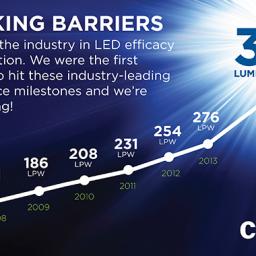More efficient new LEDs now available, over 200lm/W
 Cree's newly announced XP-G3 model of LED delivers 31% more lumens (lm) and 8% higher lm/W than its predecessor. Offering over 205 lm/W at 350mA, this marks the first time commercially-available LEDs have exceed the efficiency of low-pressure sodium lamps, commonly found in municipal streetlights. OrangeTeK has already announced they are designing a new model of streetlight with XP-G3 LEDs. In practice, however, it's likely that most users of XP-G3 LEDs will run them at higher power with reduced efficiency, rather than install five times as many LEDs, due to price. Any efficiency improvements are good news, however, as numerous cities have already installed LED streetlights, and many more have plans in the works. This seems to be motivated by the whiter appearance of LEDs compared to sodium lights, which is ironically the major source of opposition from the public, who complain about LED streetlights keeping them up at night, among other concerns.
Cree's newly announced XP-G3 model of LED delivers 31% more lumens (lm) and 8% higher lm/W than its predecessor. Offering over 205 lm/W at 350mA, this marks the first time commercially-available LEDs have exceed the efficiency of low-pressure sodium lamps, commonly found in municipal streetlights. OrangeTeK has already announced they are designing a new model of streetlight with XP-G3 LEDs. In practice, however, it's likely that most users of XP-G3 LEDs will run them at higher power with reduced efficiency, rather than install five times as many LEDs, due to price. Any efficiency improvements are good news, however, as numerous cities have already installed LED streetlights, and many more have plans in the works. This seems to be motivated by the whiter appearance of LEDs compared to sodium lights, which is ironically the major source of opposition from the public, who complain about LED streetlights keeping them up at night, among other concerns.Philips had previously demonstrated 200lm/W LEDs, and claimed they'd be available to consumers by 2015, but a search of current products only reveals far less-efficient models. The XP-G3 is available for order right now. Cree has previously demonstrated LEDs in the lab that deliver up to 303 lm/W, which is half-way to the maximum theoretical efficiency of this technology. Estimates are that as much as one quarter of the world's electrical consumption is used for lighting. Most consumers could see significant savings just by switching to florescent or LED lights in the first place. About 50 percent of lights sold in the US are halogen incandescents, which are only one quarter as efficient as LEDs, have far shorter operational lifetimes, and cost about one quarter as much.
Note that I'm using the inexpensive $1.75 generic Lowes LED bulbs (60w equiv) with 2-yr warranties, for reference. There certainly are still less-efficient older LED bulbs on the market, as well as some that are more-efficient.
http://m.lowes.com/pd/Utilitech-2-Pack-9-Watt-60W-Equivalent-3000K-A19-Medium-Base-E-26-Warm-White-Indoor-LED-Bulb/50423206
40w equiv (6w) LEDs are similarly inexpensive and more-efficient than their CFL counterparts.
However, what I like most about LEDs is that they work great at even lower power levels, too. CFLs below 40w were candelabra base with long, slow warm-up times and relatively poorer efficiency. Similarly, incandesent efficiency was on a curve, so 60W bulbs had DOUBLE the lumens output of a 40W bulb. But with LEDs you really can scale that down as far as you want. No longer is a 40w bulb the lowest-power practical choice for smaller rooms, closets, etc.
It also helps greatly that LEDs do fine in the cold, and can be switched off/on almost unlimited times, making them a great optionin refrigerators, motion sensors, etc., where CFLs don't really work at all. After all, hot bulbs in your refrigerator is about the worst waste of electricity imaginable.